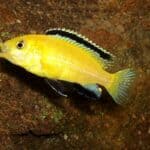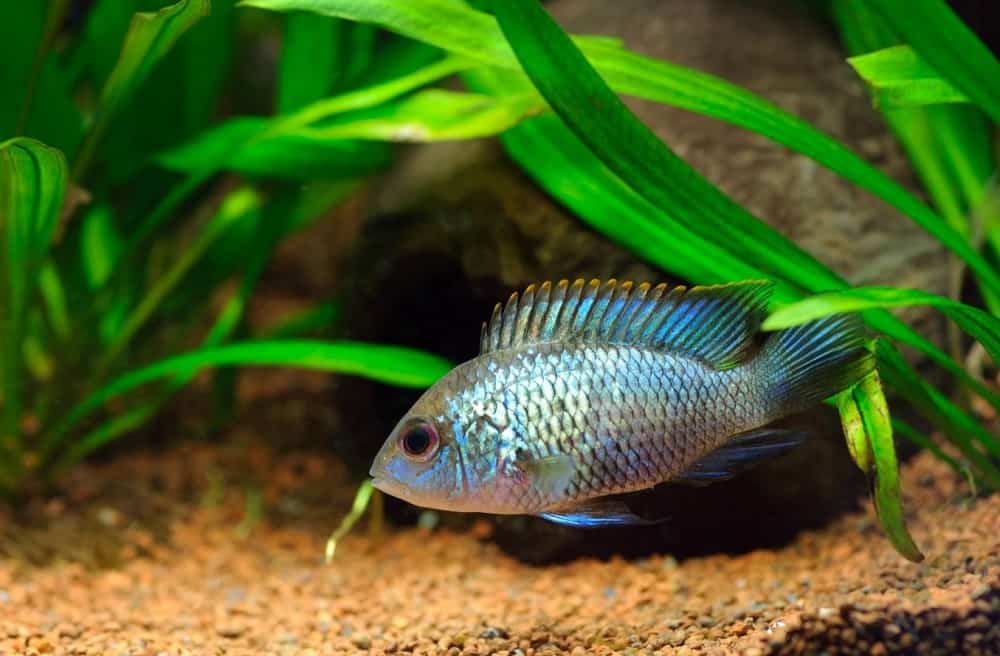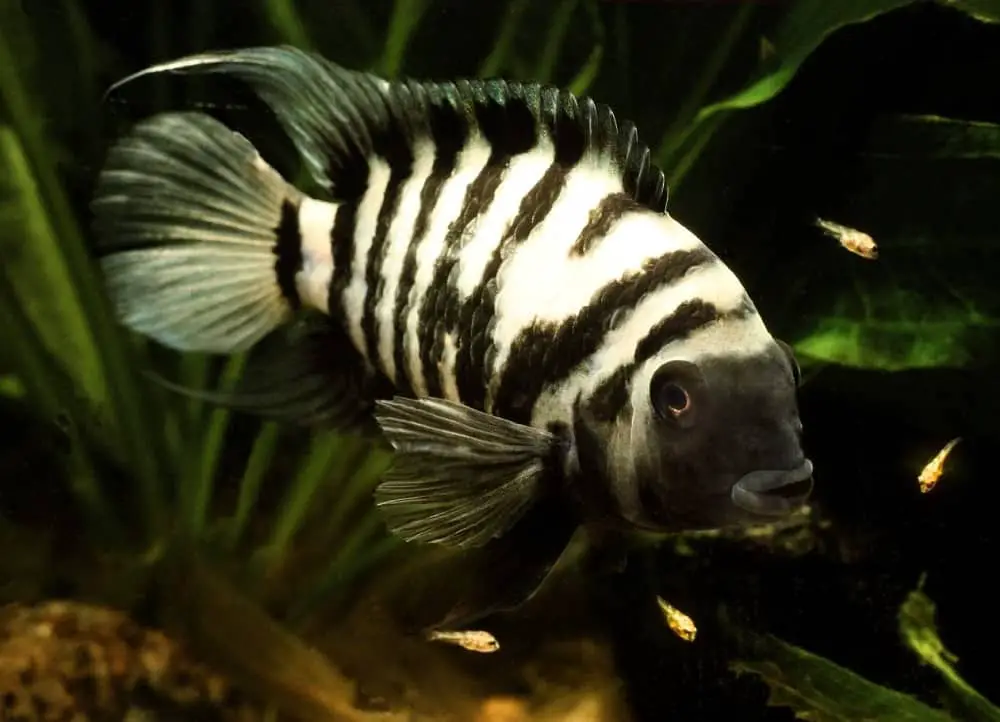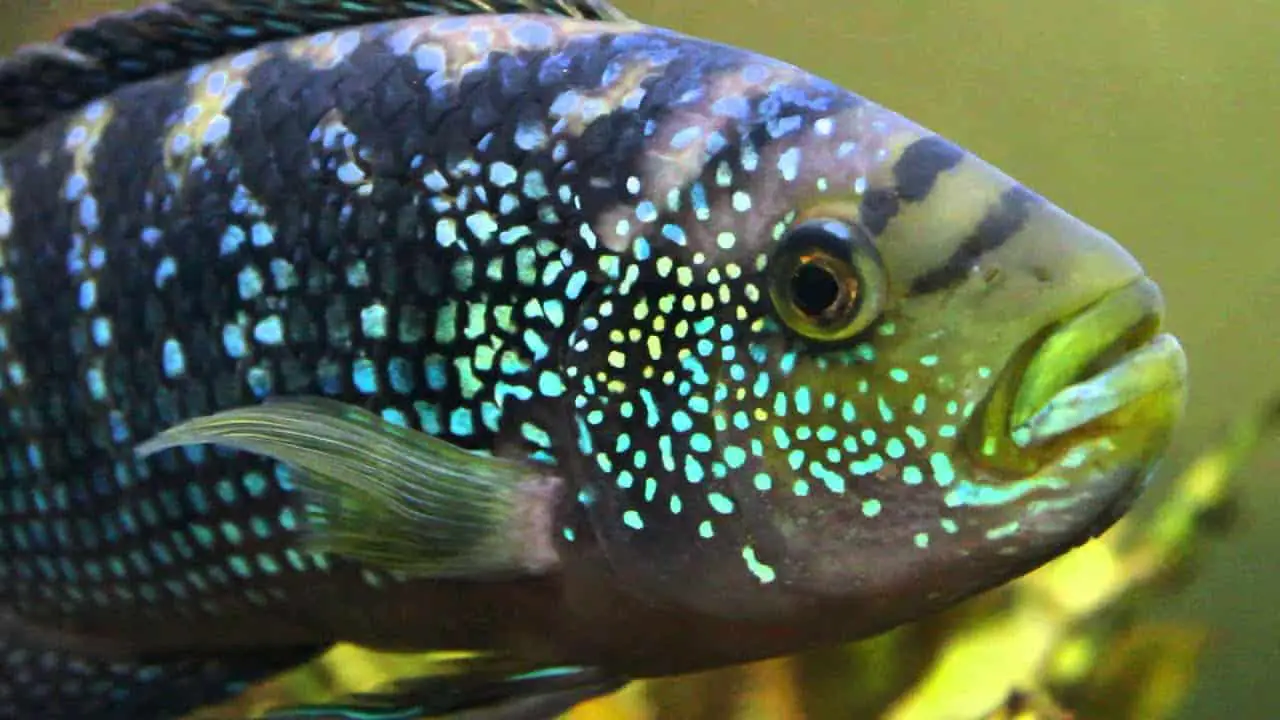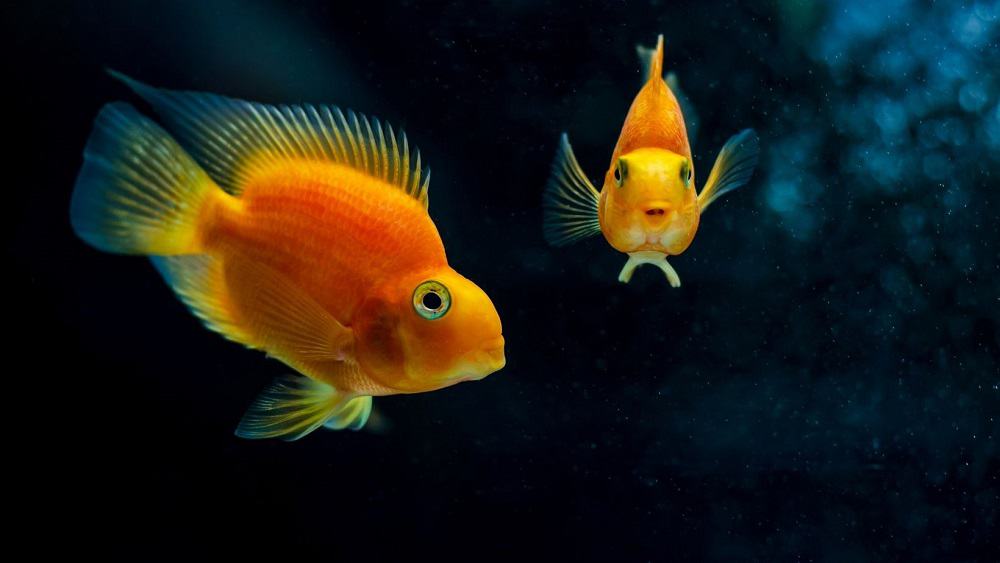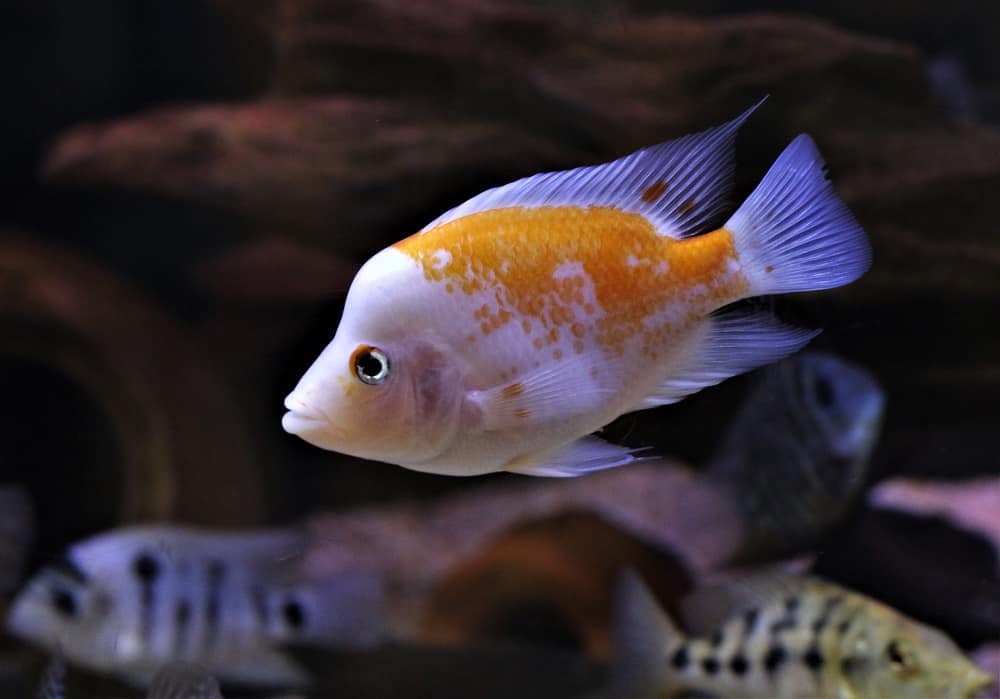Looking for something a little more exciting than the average fish? The Electric Blue Cichlid doesn’t disappoint.
This fish is stunningly beautiful and very easy to keep. But there’s more to it than meets the eye. Electric Blue Cichlids constantly explore their environment and often approach humans who are near their tank.
In this guide, we’ll give you all the information you need to care for your electric blue cichlid, including tips on diet, tank size, compatible tank mates, and more.
Species Summary
The Electric Blue Cichlid (Sciaenochromis fryeri) is a species of tropical freshwater cichlid belonging to the Cichlidae family. These cichlids are fare native to the Rift Valley in Africa, specifically Lake Malawi. They’re found all over the lake, in sandy regions, open water, and near rocky areas.
The Electric Blue Cichlid gets its name from its stunning blue coloration. While aggressive, it’s still popular for aquariums because of its vibrant color. That being said, this fish is not suitable for a typical community aquarium.
Most Blue Electric Cichlids today are bred in captivity. However, it is still possible to find fish that have been collected from nature.
If you’re interested in adding one of these fish to your tank, be aware that they can be susceptible to changes in water parameters. As such, they may be better suited for aquarists who have some experience keeping alkaline water fish.
Electric Blue Cichlid Care Guide
While electric blue cichlids are relatively easy to care for, there are a few things you’ll need to do to ensure they thrive in your aquarium. For example, it’s important to understand their ideal water parameters before bringing them home. So learn about caring for your Electric Blue Cichlids as we discuss the following topics:
Tank Size
As their name suggests, electric blue cichlids are a bright blue color. They’re also one of the larger cichlid species, reaching up to 12 inches in length. Because of their size and active nature, electric blue cichlids need a lot of space to swim and thrive.
So, what size tank do electric blue cichlids need? Experts recommend an aquarium that’s at least 26 gallons, with dimensions starting at 60″ x 20″ x 15″. This size will accommodate a small group of electric blue cichlids well. Of course, more space means happier and healthier fish.
Tank Mates
As aggressive fish, they can’t always coexist without problems with other animals. It should be kept with fish of the same size or larger. Remember that this species tends to be aggressive with similarly shaped and colored fish.
Avoid aggressive and larger species that could injure the Electric Blue Cichlid, or that could compete directly for food. Likewise, smaller fish and anything that fits in their mouths can become food. Avoid keeping it with Mbunas (smaller rock-dwelling cichlids). Avoid placing it with any other peaceful cichlids as well.
Moga Cichlid, Bristlenose Pleco, Otocinclus, Rainbowfish, Oscars, Discus Fish, Congo Tetra, Firemouth Cichlid, Pictus Catfish, Lemon Tetra, and Cory Catfish make great tank mates.
Same Species Tanks
The Electric Blue Cichlid is often kept as a single species in biotope-type aquariums, mimicking the species’ original location. But keep in mind that they will attack and kill any other male of the same species unless the aquarium is enormous.
Water Parameters
This popular fish is known for its vibrant blue coloration and its ability to thrive in a wide range of water parameters. But what exactly are the ideal Electric Blue Cichlid water parameters? Keep reading to find out!
The perfect temperature for keeping the Electric Blue Cichlid in an aquarium is 75 to 82 F. The ideal pH range is between 7.8 to 8.6, and the hardness is 10 – 18° dH.
What to Put in Their Tank
As with any other aquatic animal, there are a few things you’ll need to consider before adding electric blue cichlids to your tank. Here’s a quick rundown of what you’ll need to create a healthy environment for your new fishy friends: a well-sized aquarium heater, a good filtering system, and adequate lighting.
In order to maintain a successful Electric Blue Cichlid aquarium, it is critical to have proper decoration. This includes adding rocks grouped in aquascaping to provide territories and hiding places for the fish.
The stones must be carefully buried and supported against each other to avoid cave-ins, fish getting stuck, or rocks hitting the glass. It is also important to keep areas open for the fish to swim freely.
Moreover, the stones will provide several places for each fish to form and protect their territory and use as a hiding place in case of aggression by a dominant male.
Once you’ve got all of that sorted, it’s time to add some fish!
Common Diseases
Although they are generally healthy fish, there are a few common diseases that Electric Blue Cichlids can develop.
One of the most common diseases is Malawi bloat. This is caused by a build-up of toxins in the fish’s body, and can be fatal if not treated promptly. Symptoms include a swollen belly, lethargy, and loss of appetite.
Another common disease is acidosis. This is caused by a change in the pH balance of the water, which can be fatal if not corrected. Symptoms include gasping at the surface of the water, listlessness, and loss of appetite.
If you suspect that your fish has either of these diseases, it is important to seek veterinary care immediately. With prompt treatment, most fish can recover from these diseases.
Food and Diet
This species, like other Cichlids, is a carnivore, mainly piscivorous, feeding on smaller fish. A good combination of using a high-quality commercial feed and live, fresh or frozen foods, will make these fish look much more vivid and their behavior closer to natural.
Of course, as with all fish, it’s important to vary their diet to ensure they’re getting all the nutrients they need.
They are always hungry, so you need to be careful not to overfeed them. It’s best to feed them small amounts several times a day rather than one large meal.
Lifespan
As any experienced aquarist knows, the lifespan of a fish in captivity can differ quite significantly from its lifespan in the wild. In an aquarium with all the correct parameters kept stable and with an ideal diet, this animal can live around eight years, with the most common being around six years.
In nature, these animals are prone to live less, as they are predisposed to diseases, attacks from other animals, and environmental causes.
Appearance
The Electric Blue Cichlid has an elongated and robust body, typical of the cichlids of Lake Malawi.
One of the characteristics of this species is the magnificent metallic blue color of the males, common to all existing variants. However, according to the lake’s location from which it comes, it presents slight changes, mainly in the color of the anal fin, which can vary from almost red-orange to a discreet yellow.
Another feature that may differ from location to location is the white stripe on the dorsal fin, which can be located on the fin or extended along the top of the head. The shade of blue varies according to the mood of the fish, ranging from an intense metallic blue to a light shade interspersed with vertical gray stripes.
A third characteristic that can vary from place to place is the length, which in some areas is 4.7 in, and in different locations, it can reach 8 inches. In an aquarium, and with the correct diet, almost all specimens easily reach 15 cm. Females generally have shades of gray with a slight bluish sheen, being smaller than males and around 12 cm.
Size
The Eletric Blue Cichlid can quickly grow to 8 inches in length when given proper care and diet.
Behavior and Temperament
It is a tropical fish species with aggressive behavior and should not be kept in a standard community aquarium since it is a voracious predator. It must live in an environment suitable for the species, with fish of the same size and behavior.
In addition, it is a fish known for its strong tendency to be aggressive towards fish of similar shape and color. It can become aggressive towards other fish during the breeding season. Male harassment of females is intense, so a harem with many females is advisable. Some aquarists also report that the aggressiveness of this fish increases when it is in inappropriate places.
Breeding
It is an oviparous and maternal mouth incubator species; after spawning and fertilization, the mother keeps the eggs in her mouth.
As well as being oviparous, the Electric Blue Cichlid is a polygamous fish, meaning you must breed a male with several females. Mating takes place in a place previously chosen by the couple, and the male attracts the female in a ritual of movements. The female will lay the eggs in a spot on the ground (usually a surface such as a rock), and the male will then fertilize.
After each egg is fertilized, the male dances around the female again until she releases a new one. This process lasts between 20 and 30 minutes, and some females can lay about 50 to 60 eggs.
Being a buccal incubator, the female places the eggs in her mouth for hatching, at which point the male can be taken out of the aquarium. Incubation lasts about 20 days, after which the fry is ready to live outside the mother’s mouth.
Gender Differences: Male vs Female
Males and females of this species look different. Adult males are a solid electric blue color, while females are more grayish with some darker stains.
The electric blue color of males is thought to be a way to attract females and intimidate other males.
Electric Blue Cichlid Fun facts
● This fish was first imported and classified as Sciaenochromis ahli and is still named as such in much of the available literature.
● Due to geographical variation, there are different varieties. We strongly advise not to mix different types.
● This species is known for its ease of hybridizing; this must be considered when choosing mates.
● It belongs to a group commonly known as Peacock cichlids or Haps.
Reference
Kazembe, J., Makocho, P. & Mailosi, A. 2006. Sciaenochromis fryeri. In: IUCN 2007. 2007 IUCN Red List of Threatened Species. <www.iucnredlist.org>. Downloaded on 24 June 2008.

